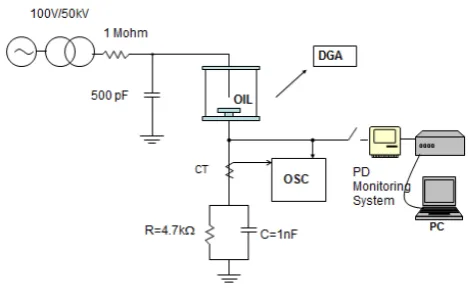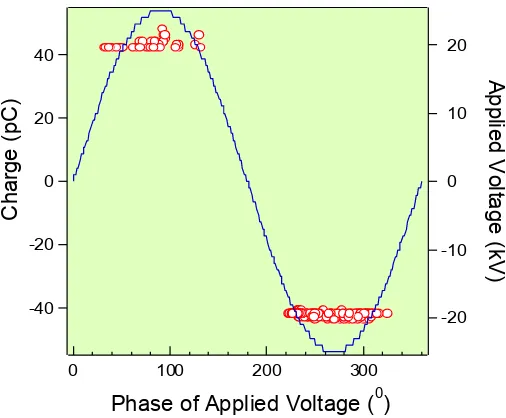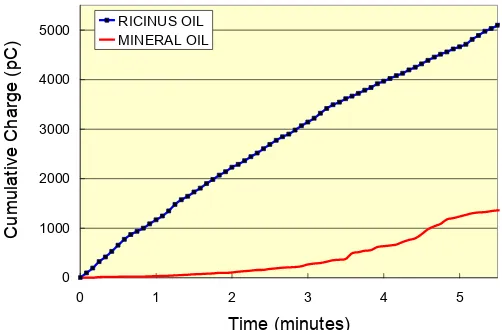Dielectric Properties, Partial Discharge Properties,
and Dissolved Gas Analysis of Ricinnus Oils as
Biodegradable Liquid Insulating Materials
Umar Khayam, Abdul Rajab, Suwarno
School of Electrical Engineering and InformaticsInstitut Teknologi Bandung INDONESIA
Abstract—In this paper partial discharge (PD) characteristics of ricinnus oil and dissolved gas analysis (DGA) due to PD are investigated. The examination showed that the properties of ricinnus oil as a dielectric material such as breakdown voltage, dielectric constant, loss factor, neutralization number, and flash point complied with IEC standard. The II-q-n pattern of PD and the change of the pattern with applied voltage were observed. Dissolved gas analyses due to PD in oil were also performed. The results were compared with ones in mineral oil which have been using as insulating materials in high voltage apparatus. The results showed that the PDIV of ricinnus oil is higher than one of mineral oil. Types and pattern of dissolved gas due to PD in ricinnus oil were similar with ones in mineral oil. The total combustible gas in ricinnus oil is a little bit higher than one in mineral oil. The measurement of the cumulative charge during 5 minutes showed that PD activity in ricinus oil is higher than one in mineral oil. The results showed that the gassing tendency due to PD of ricinus oil is good with small amount of combustible gases.
Keywords - partial discharges, dissolved gas analysis, ricinnus oil, effect of temperature
I. INTRODUCTION
It is well known that petroleum-based mineral oils have been used for liquid insulation in the high voltage apparatuses. This is because the insulating oils have excellent dielectric properties such as high electric field strength, low dielectric losses and good long-term performance. The oils also can be obtained at reasonably low price.
However, conventional transformer insulating materials like mineral oils or synthetic insulating liquids are usually non-biodegradable. It can contaminate soil and water when serious spill take place. This may disturb the plantation and other lives. Then, the oils were extracted from petroleum, which is going run out in the future, since petroleum is one of non-renewable energy source. It was also reported that water absorption of paper under natural oils was much lower than mineral oil [1]. Furthermore, insulation end of life (life time) of paper which are commonly used in a transformer, is much longer when aged under natural oil compared to that mineral oils [2]. Based on the view above, the alternatives of liquid insulating materials which are friendly to the environment were investigated recently
One of the promising vegetable oils for dielectric materials is ricinus oil [1,2]. Ricinnus oil is obtained from ricinnus comunnis seeds. The typical height of the plant is 3-4 m. The ricinnus seed has length of about 2 cm and weight of 3-5 g. Ricinnus can be found at highland with low precipitation due to its hydrophobicity. The ricinnus oil is widely used as agent for pharmacy, soap and even for lubricant. From ricinnus seeds, crude oils can be obtained by bleaching, blender, pressing and filtering. Refining of the crude oil is necessary to get better oil. The refining process contains balancing, neutralization, decolorization and filtration.
In this paper partial discharge (PD) characteristics of ricinus oil and dissolved gas analysis (DGA) due to PD are investigated. The examination showed that the properties of ricinus oil as a dielectric material such as breakdown voltage, dielectric constant, loss factor, neutralization number, and flash point complied with IEC standard. The I-q-n pattern of PD and the change of the pattern with applied voltage were observed. Dissolved gas analyses due to PD in oil were also performed. The results were compared with ones in mineral oil which have been using as insulating materials in high voltage apparatus. The results showed that the PDIV of ricinnus oil is higher than one of mineral oil. Types and pattern of dissolved gas due to PD in ricinus oil were similar with ones in mineral oil. The total combustible gas in ricinnus oil is a little bit higher than one in mineral oil. The measurement of the cumulative charge during 5 minutes showed that PD activity in ricinus oil is higher than one in mineral oil. The results showed that the gassing tendency due to PD of ricinus oil is good with small amount of combustible gases.
II. EXPERIMENTAL SETUP 2.1. Sample
Samples used in the experiment were CRO (Crude Ricinnus Oil), RRO (Refined Ricinnus Oil) and RROT (Refined icinnus Oil with treatment).
2.2 Method of Testing
There are some steps of the testing of ricinnus oil as a candidate of the insulation materials. The first test examined whether the breakdown voltage, dielectric constant, loss
1249
C-23 2012 IEEE International Conference on Condition Monitoring and Diagnosis 23-27 September 2012, Bali, Indonesia
factor, neutralization number, and flash point of the ricinnus oil were complied with IEC standard. The second test examined the effect of temperature on the above parameters and the dissolved gases analyze (DGA). The third test examined the characteristics of partial discharge (PD) in the ricinnus oil and the DGA due to PD. The fourth test is ageing test of ricinnus oil. The first test and the third test was reported in this paper.
2.3 Dielectric Properties Test of Ricinnus Oil
Breakdown Voltage
Breakdown voltage was measured using bispherical standard cell with spacing of 2.5 mm in Liquid Dielectric Test Set LD60 from Phenix Technologies. AC voltage with frequency of 50 Hz was applied with increasing rate of 2 kV/s.
Losses factor (tan ¥) and dielectric constant
Losses factor (tan ¥) and dielectric constant of the samples were measured using Schering bridge with a gas standard capacitor of 37.92 pF. The oil sample was put in a liquid test cell from Tettex Instruments.
Viscosity
Viscosity of samples is determined using Oswald viscometer, analytical scale, picnometer and athermometer according to ASTM D-455.
Neutralization number
Neutralization number indicates the amount of KOH (in mg) to be added to neutralize each gram of an oil. The neutralization number of oils used in this experiment is determined according to ASTM D-974. Phenoptalin is used as indicator during titration.
2.4 Experimental setup for PD measurement in ricinnus oil The experimental setup is shown in Figure 1. The oil sample was put on the acrylic chamber. The samples are ricinnus oil and mineral oil.
PD was generated in oil with a needle-plane electrode system. The gap between the electrodes is 20 mm. The tip radius of the needle is 0.01 mm. To avoid breakdown, acrylic with thickness of 15 mm was placed above the plane electrode. The gap between needle tip and acrylic surface was 5 mm.
PD was measured using RC detector and was observed in the oscilloscope. PD data was also presented in the form of I -q-n pattern by PD monitoring system.
After PD occurred in the oil, dissolved gas in the oil was analyzed. Dissolved gases in the oil samples were measured using gas chromatograph HP 6890 integrated with Automatic Liquid Sampler HP 7649. The concentration of combustible gasses i.e. H2 (hydrogen), C2H6 (Ethane), C2H4 (ethylene) and C2H2 (Acetylene) was determined using DGA(dissolved gas analysis).
Fig. 1 Experimental setup for PD measurement in ricinnus oil
III. EXPERIMENTAL RESULTS AND DISCUSSION
3.1 Dielectric Properties of Ricinnus Oil
Table 1 shows the comparison of several dielectric properties of ricinnus oils with the corresponding values from IEC standard. From the table it is seen that RROT oil sample is the only candidate to be considered as liquid insulating material as long as the existing standard (i.e. IEC) is used to justify the compliant of the liquid insulating materials. Some treatment is required to reduce the viscosity and the dielectric losses factor.
Table 2 shows several dielectric properties of a number of oils including mineral oil, silicone oil, crude palm of (CPO), refined coconut oil (RCO), and refined ricinus oil with treatment (RROT) [3,4].
Table 1
The comparison of several dielectric properties of ricinnus oils with the corresponding values from IEC standard
Parameter CRO RRO RROT IEC
Breakdown voltage
(kV) 30.2 38.2 40.5 >30
Tan delta 0.127 0.029 0.026 0.025*
Dielectric constant (
H
r) 2.33 2.11 2.1 2.1-2.5Neutralization number
(mgKOH/g) 2.4 0.74 0.31 <0.5
Viscosity (cSt) 100.1 19.4 16.1 3.0-16.0
*special for vegetable oil
0.0
o RICINUS OILMINERAL OIL
-40
Phase of Applied Voltage (
0)
-20
Table 2 Dielectric properties of several oils
3.2 PD characteristics of Ricinus Oil
PD inception voltage of the ricinus oil was 18 kV, slightly higher than that in mineral oil, 17 kV. Figure 2 shows the ф -q-n patter-q-n of PD i-q-n rici-q-nus oil measured at 25 kV. PD occurred only at negative half cycle at 20 kV, while it occurred at both half cycles at 25 kV. The charge magnitude and pattern were almost same at both half cycles, while PD number was higher at negative half cycle. The magnitude and number of PD in both half cycles were proportional to the applied voltage. These indicate that the PD occurrence in ricinus oil is strongly dependent on the instantaneous applied voltage. These characteristics were also observed in mineral oil.
Figure 2 I-q-n pattern of ricinus oil at 25 kV
3.3 Dissolved Gases Analysis of Ricinus Oil
Dissolved gases due to PD were analyzed with a gas chromatography. Analyzed gas components were total combustible gases (TCG): H2 (hydrogen), CH4 (methane), C2H6 (ethane), C2H4 (ethylene) and C2H2 (acetylene). H2 was not detected. The most dominant gas was CH4 (5.1 ppm for ricinnus oil and 6.1 ppm for mineral oil). It was followed by C2H4, C2H6, and C2H2. Each gas component was expressed as the ratio to the CH4 quantity and was plotted.
Figure 3 shows the pattern of dissolved gas due to PD in ricinnus and mineral oil. It appears that for the same concentration of CH4, the concentration of other combustible gases due to PD in ricinnus oil was higher than one in mineral oil. It is considered that PD activity and injected energy in ricinnus oil are higher than those in mineral oil.
It was supported by the experimental results which indicated that the cumulative charge at 25 kV for PD in ricinus was higher than ones in mineral oil as shown in Figure 4. Total cumulative charges at 25 kV applied voltage were 4662 pC and 1237 pC for ricinus oil and mineral oil, respectively. Even it is not shown here, PD number and charge in ricinus oil at 25 kV were also more than ones in mineral oil.
TCG of hydrocarbon gases due to PD in ricinus oil was 16.1. It is higher than TCG of ones in mineral oil (15.7), but it is still much lower than limit level for condition 1 (TCG=720) according to IEEE [3]. The results showed that the gassing tendency due to PD of ricinus oil is good with small amount of combustible gases.
Because the PD characteristics of ricinus oil are similar with mineral oil (see part 3.2), now we examined whether diagnosis charts of DGA established in mineral oil [5] may be used for ricinus oil. The coordinate of gas concentration ratio of (C2H2/C2H4), (C2H4/C2H6) of ricinus oil is (0.71, 1.2). If it is plotted in diagnosis charts of DGA established in mineral oil, it is in the area of discharge with middle energy discharge. Diagnostic charts for mineral oil are seemed to be applicable to ricinus oil.
Figure 3 Pattern of dissolved gases in ricinnus and mineral oil due to PD
Parameter Mineral Oil Silicone Oil Palm oil Coconat oil Ricinnus Oil IEC
Breakdown voltage (kV) 45 40 17 36.6 40.5 >30
Tan delta 0.01 0.01 0.6 0.1 0.026 0.025
Dielectric constant (
H
r) 2.1 2.7 3.5 3.2 2.1 2.1-2.5Viscosity (cSt) 9.2 39 42 25.7 16.1 3.0-16.0
0 1000 2000 3000 4000 5000
0 1 2 3 4 5
Time (minutes)
C
u
mu
la
ti
ve
C
h
a
rg
e
(p
C
)
RICINUS OIL MINERAL OIL
Figure 4 Cumulative Charge of ricinnus oil and mineral oil at 25 kV applied voltage
IV. CONCLUSIONS
The dielectric properties of crude ricinnus oils (CRO), refined ricinnus oil (RRO), and refined ricinnus oil with the treatment (RROT) has been investigated. Among the samples, RROT oil sample is the best which is considered as a candidate for biodegradable insulating materials. Some treatment is required to reduce the viscosity and the dielectric losses factor.
Partial discharge characteristics of ricinnus oil and dissolved gas analysis due to PD are investigated. PD patterns in ricinnus oil were similar with ones in mineral oil. For the same applied voltage (electric field stress), PD activities in ricinnus oil were higher than ones in mineral oil. Types and pattern of dissolved gas due to PD in ricinnus oil were similar with ones in mineral oil. The combustible gas concentration ratio in ricinnus oil was a little bit higher than one in mineral oil.
REFERENCES
[1] Suwarno, M. Ilyas,”Study on the Characteristics of Jatropha and Ricinnus Seed Oils as Liquid Insulating Materials”, ISH 2007, Paper T9-436, Ljubljana, 2007.
[2] Suwarno, M. Ilyas, Rubadi,” Effects of temperature on Dielectric properties of Rhicinnus Oils as insulating liquid,” CMD 2008, Paper C2-04, Beijing, 2008.
[3] Suwarno, F. Sitinjak, I Suhariadi, L. Imsak, “Study on the Characteristics of Palm Oil and it’s Derivatives as Liquid Insulating Materials”, 7th International Conf. on Properties andApplications of Dielectric Materials, Nagoya, June, 2003.
[4] Suwarno, Aditama, “Characteristics of Palm Oil as Liquid Insulating Material”, ISEIM, Kitakyushu, Japan, June, 2005.
[5] IEEE Std. C57. 104-1991


